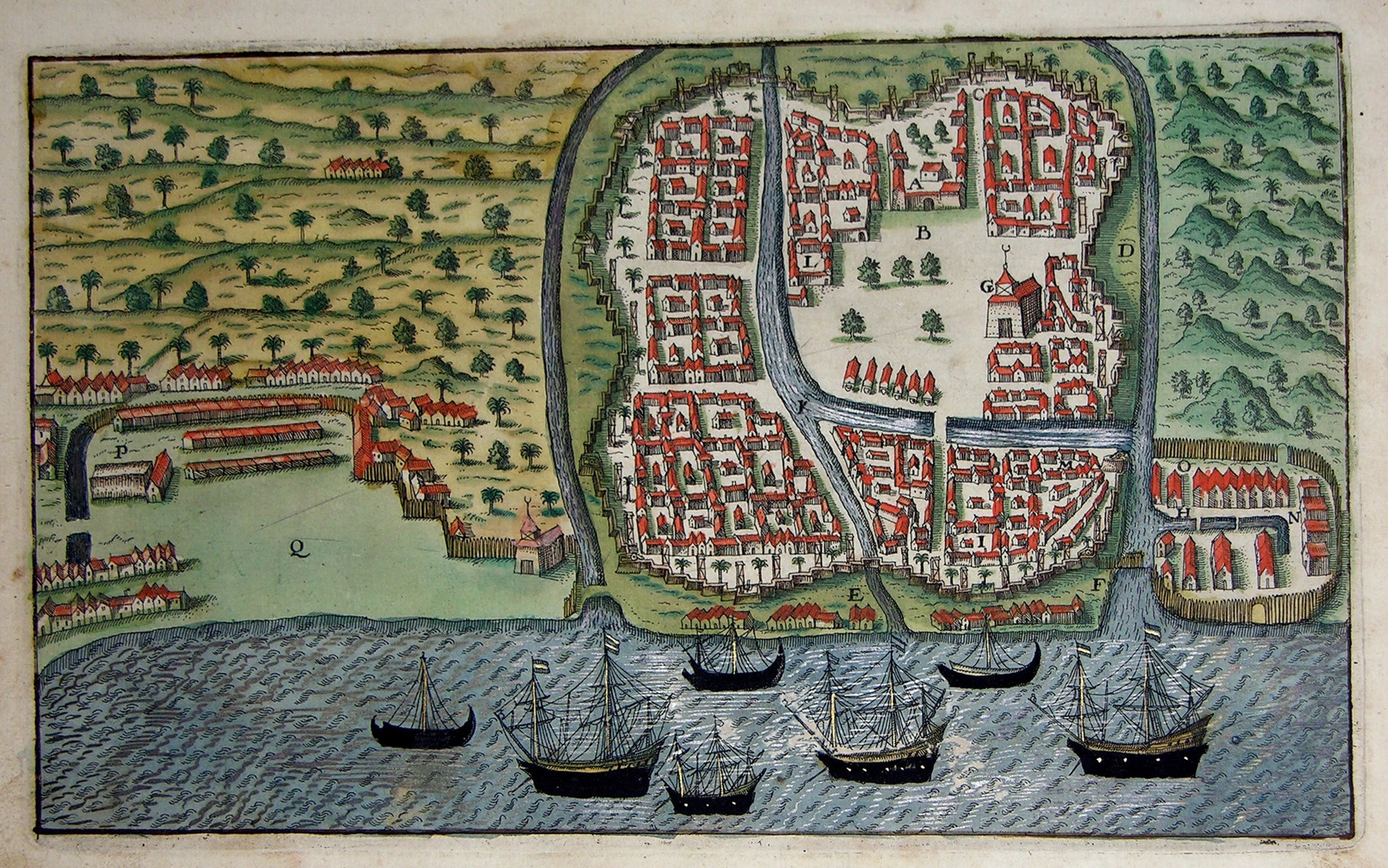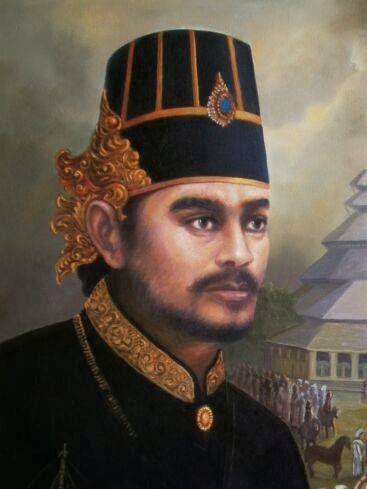|
Hasanuddin
Maulana Hasanuddin (also spelled Hasanuddin) was a ruler of the Banten Sultanate from c. 1552 to 1570. Hasanuddin was a Azmatkhani Ba 'Alawi Sayyid, the son of Sunan Gunungjati and Nyai Ratu Kawunganten. He extended the domains of Banten to the pepper-producing region of Lampung, in South Sumatra Sumatra is one of the Sunda Islands of western Indonesia. It is the largest island that is fully within Indonesian territory, as well as the sixth-largest island in the world at 473,481 km2 (182,812 mi.2), not including adjacent i .... This area, which already had long-standing ties with West Java, facilitated Banten's rise to prominence as a pepper port.M.C. Ricklefs, ''A History of Modern Indonesia Since c. 1300'', 2nd ed., Stanford: Stanford University Press, 1994, p. 38 Notes Sultans of Banten 16th-century rulers in Asia Pepper trade 1570 deaths Indonesian people of Arab descent {{indonesia-bio-stub ... [...More Info...] [...Related Items...] OR: [Wikipedia] [Google] [Baidu] |
Banten Sultanate
The Banten Sultanate (كسلطانن بنتن) was a Bantenese Islamic trading kingdom founded in the 16th century and centred in Banten, a port city on the northwest coast of Java; the contemporary English name of both was Bantam. It is said to have been founded by Sunan Gunungjati, who had previously founded Cirebon. Once a great trading centre in Southeast Asia, especially of pepper, the kingdom reached its apogee in the late 16th and mid-17th centuries. By the late 17th century its importance was overshadowed by Batavia, and finally annexed to Dutch East Indies in 1813. Its core territory now forms the Indonesian province of Banten. Today, in Old Banten, the Great Mosque of Banten is an important destination for tourists and for pilgrims from across Indonesia and from overseas. Formation Before 1526 CE, a settlement called Banten was situated about ten kilometres inland from the coast on the Cibanten River, in the area which is today occupied by the southern suburbs of ... [...More Info...] [...Related Items...] OR: [Wikipedia] [Google] [Baidu] |
List Of Sultans Of Banten
The Sultan of Banten was the ruler of Banten Sultanate in the province of Banten Banten ( id, Banten; Sundanese: , romanized ''Banten'') is the westernmost province on the island of Java, Indonesia. Its capital city is Serang. The province borders West Java and the Special Capital Region of Jakarta on the east, the Java Se ..., Indonesia, which had triumphed at the western tip of Java island. The sultanate was founded by Maulana Hasanuddin of Banten who reigned between 1552 to 1570. It was one of the most important Muslim dynasties in pre-colonial Indonesia that made contact with the Europeans. List of Sultans of Banten * Sunan Gunungjati, Syarif Hidayatullah or ''Sunan Gunung Jati'' from Sultanate of Cirebon # Maulana Hasanuddin of Banten, Sultan Maulana Hasanuddin or ''Prince Sabakinking'' 1552–1570 # Maulana Yusuf of Banten, Sultan Maulana Yusuf or ''Prince Pasareyan'' 1570–1585 # Maulana Muhammad of Banten, Sultan Maulana Muhammad or ''Prince Sedangrana'' 1585� ... [...More Info...] [...Related Items...] OR: [Wikipedia] [Google] [Baidu] |
Old Banten
Old Banten (Indonesian ''Banten Lama'') is an archaeological site in the northern coast of Serang Regency, Banten Province, Banten, Indonesia. Located 11 km north of Serang city, the site of Old Banten contains the ruin of the walled port city of Banten (town), Banten, the 16th-century capital of the Sultanate of Banten. Since 1995, Old Banten has been proposed to UNESCO World Heritage. History Banten was a 16th-century port city known for its pepper. The city flourished when the Islamic Banten Sultanate reached its peak during the 17th century. There was a period of intense conflicts with the Dutch East India Company (VOC) over the trade of spices, which eventually led to the dissolution of the Sultanate in Banten and to the city's decline. Today, the site where the city of Banten remains is known as Old Banten. It is a well-known tourist attraction, where many locals visit to pay their ziarah, respects and pray at the graves of Sultan Maulana Hasanuddin of Banten, Maulana ... [...More Info...] [...Related Items...] OR: [Wikipedia] [Google] [Baidu] |
Great Mosque Of Banten
Great Mosque of Banten ( id, Masjid Agung Banten) is a historic mosque in Old Banten, 10 km north of Serang, Indonesia. The 16th-century mosque was one of the few surviving remnants of what used to be the port city of Banten, the most prosperous trading center in the Indonesian archipelago after the fall of Demak Sultanate in mid-16th century. History The Great Mosque of Banten shows eclectic design, a proof of the international influence in Banten at the time of its construction in 1552. The mosque was constructed in Javanese style during the reign of Sultan Maulana Yusuf, the third Sultan of Banten Sultanate, in Dzulhijjah 966 (1566 CE). A Javanese-styled ''pawestren'' (side hall, used for female's praying hall) was added during the reign of Maulana Muhammad (1580-1586). The southern ''serambi'' (porch) of the mosque was converted into a tomb containing about 15 graves. In 1632, a 24-meter minaret was added to the mosque complex. The minaret was designed by ... [...More Info...] [...Related Items...] OR: [Wikipedia] [Google] [Baidu] |
Sunan Gunungjati
Sunan Gunungjati (1448–1568) was one of the Wali Songo, or nine saints of Islam revered in Indonesia. He founded the Sultanate of Banten, as well as the Sultanate of Cirebon on the north coast of Java. Gunungjati was born Syarif Hidayatullah ( ar, شريف هداية الله '')'' in 1448 CE, the child of a dynastic union between Syarif Abdullah Maulana Huda, an Egyptian of Hashemite descent, and Nyai Rara Santang, daughter of Prabu Siliwangi, King of Sunda (Pajajaran). As such, Syarif Hidayatullah could claim descent, on his paternal side, from the Islamic prophet Muhammad, and on his maternal side, a Hindu Devaraja of the Sunda Kingdom. There is much historical uncertainty as to his early life and later career in the Indonesian Archipelago. Some say that he was born in Pasai, one of the earliest centres of Islam in Southeast Asia; whilst others say that he was born in Pajajaran, capital of his maternal grandfather's Kingdom of Sunda. He is reported to have married a siste ... [...More Info...] [...Related Items...] OR: [Wikipedia] [Google] [Baidu] |
Lampung
Lampung (Lampung: ), officially the Province of Lampung ( id, Provinsi Lampung) is a province of Indonesia. It is located on the southern tip of the island of Sumatra. It has a short border with the province of Bengkulu to the northwest, and a longer border with the province of South Sumatra to the north. It is the original home of the Lampung people, who speak their own language, and possess their own written script. Its capital is Bandar Lampung. The province covers a land area of 35,376 sq.km and had a population of 7,608,405 at the 2010 census, 9,007,848 at the 2020 census, and 9,081,792 according to the official estimates for mid 2021,with three-quarters of that being descendants of Javanese, Madurese, and Balinese migrants. These migrants came from more densely populated islands, in search of available land, as well as being part of the national government's Indonesian transmigration program, of which Lampung was one of the earliest and most significant transmigrati ... [...More Info...] [...Related Items...] OR: [Wikipedia] [Google] [Baidu] |
16th-century Rulers In Asia
The 16th century begins with the Julian year 1501 ( MDI) and ends with either the Julian or the Gregorian year 1600 ( MDC) (depending on the reckoning used; the Gregorian calendar introduced a lapse of 10 days in October 1582). The 16th century is regarded by historians as the century which saw the rise of Western civilization and the Islamic gunpowder empires. The Renaissance in Italy and Europe saw the emergence of important artists, authors and scientists, and led to the foundation of important subjects which include accounting and political science. Copernicus proposed the heliocentric universe, which was met with strong resistance, and Tycho Brahe refuted the theory of celestial spheres through observational measurement of the 1572 appearance of a Milky Way supernova. These events directly challenged the long-held notion of an immutable universe supported by Ptolemy and Aristotle, and led to major revolutions in astronomy and science. Galileo Galilei became a champion of ... [...More Info...] [...Related Items...] OR: [Wikipedia] [Google] [Baidu] |
Sultans Of Banten
Sultan (; ar, سلطان ', ) is a position with several historical meanings. Originally, it was an Arabic abstract noun meaning "strength", "authority", "rulership", derived from the verbal noun ', meaning "authority" or "power". Later, it came to be used as the title of certain rulers who claimed almost full sovereignty (i.e., not having dependence on any higher ruler) without claiming the overall caliphate, or to refer to a powerful governor of a province within the caliphate. The adjectival form of the word is "sultanic", and the state and territories ruled by a sultan, as well as his office, are referred to as a sultanate ( '. The term is distinct from king ( '), despite both referring to a sovereign ruler. The use of "sultan" is restricted to Muslim countries, where the title carries religious significance, contrasting the more secular ''king'', which is used in both Muslim and non-Muslim countries. Brunei and Oman are the only independent countries which retain the tit ... [...More Info...] [...Related Items...] OR: [Wikipedia] [Google] [Baidu] |
Sumatra
Sumatra is one of the Sunda Islands of western Indonesia. It is the largest island that is fully within Indonesian territory, as well as the sixth-largest island in the world at 473,481 km2 (182,812 mi.2), not including adjacent islands such as the Simeulue, Nias, Mentawai, Enggano, Riau Islands, Bangka Belitung and Krakatoa archipelago. Sumatra is an elongated landmass spanning a diagonal northwest–southeast axis. The Indian Ocean borders the northwest, west, and southwest coasts of Sumatra, with the island chain of Simeulue, Nias, Mentawai, and Enggano off the western coast. In the northeast, the narrow Strait of Malacca separates the island from the Malay Peninsula, which is an extension of the Eurasian continent. In the southeast, the narrow Sunda Strait, containing the Krakatoa Archipelago, separates Sumatra from Java. The northern tip of Sumatra is near the Andaman Islands, while off the southeastern coast lie the islands of Bangka and Belitung, Karim ... [...More Info...] [...Related Items...] OR: [Wikipedia] [Google] [Baidu] |
Ba 'Alawi Sada
The Ba 'Alawi sadah or Sadah Ba 'Alawi ( ar-at, السادة آل باعلوي, al-sādatu al-bā'alawiy) are a group of Hadhrami Sayyid families and social group originating in Hadhramaut in the southwest corner of the Arabian Peninsula. They trace their lineage to Sayyid al-Imam Ahmad al-Muhajir bin Isa al-Rumi born in 873 (260H), who emigrated from Basra to Hadhramaut in 931 (320H) to avoid sectarian violence, including the invasion of the Qaramite forces into the Abbasid Caliphate. The origin The word Sadah or Sadat ( ar, سادة) is a plural form of word ar, سيد (Sayyid), while the word Ba 'Alawi or ''Bani 'Alawi'' means ''descendants of Alawi ''(''B''ā is a Hadhramaut dialect form of ''Bani''). In sum, Ba'alawi are Sayyid people who have a blood descendant of the Islamic prophet Muhammad through Alawi ibn Ubayd Allah ibn Ahmad al-Muhajir. Meanwhile, Alawiyyin ( ar, العلويّن; ) Sayyid term is used to describe descendants of Ali bin Abi Talib from Hu ... [...More Info...] [...Related Items...] OR: [Wikipedia] [Google] [Baidu] |
Black Pepper
Black pepper (''Piper nigrum'') is a flowering vine in the family Piperaceae, cultivated for its fruit, known as a peppercorn, which is usually dried and used as a spice and seasoning. The fruit is a drupe (stonefruit) which is about in diameter (fresh and fully mature), dark red, and contains a stone which encloses a single pepper seed. Peppercorns and the ground pepper derived from them may be described simply as ''pepper'', or more precisely as ''black pepper'' (cooked and dried unripe fruit), ''green pepper'' (dried unripe fruit), or ''white pepper'' (ripe fruit seeds). Black pepper is native to the Malabar Coast of India, and the Malabar pepper is extensively cultivated there and in other tropical regions. Ground, dried, and cooked peppercorns have been used since antiquity, both for flavour and as a traditional medicine. Black pepper is the world's most traded spice, and is one of the most common spices added to cuisines around the world. Its spiciness is due to the ch ... [...More Info...] [...Related Items...] OR: [Wikipedia] [Google] [Baidu] |









